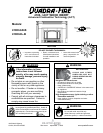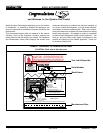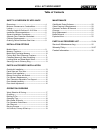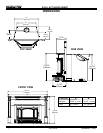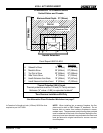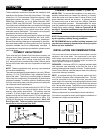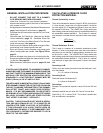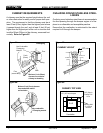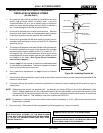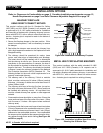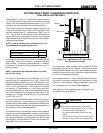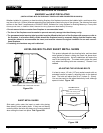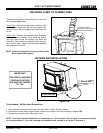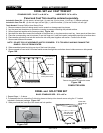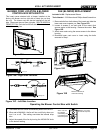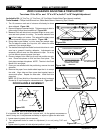
4100-I ACT WOOD INSERT
Page 6
September 1, 2008
R
250-7201E
AVOID FIRE: To ensure that insulation or any other com-
bustible material does not contact the chimney, a chimney
inside the house must have at least 2 inches (51mm) of air
space clearance around
t
he chimney. A chimney outside
the house must have at least one
inch (25mm) clearance
to the combustible structure. Noncombustible re stops
must be installed at the spaces where the chimney passes
through oors and/or ceilings.
Canadian installations require a full reline of
the chimney
CHIMNEY HEIGHT/DRAFT
To be sure that your Quadra-Fire insert burns properly, the
chimney draft (static pressure) should be approximately
-0.10” water column (W.C.) during a high burn and -0.04”
W.C. during a low burn, measured six inches (152mm) above
the top of the insert after one hour of operation at each burn
setting.
NOTE: These are guidelines only, and may vary somewhat
for individual installations.
The insert was designed for and tested on a six inch (152mm)
chimney, 12 ft-14 ft (60-420cm) high, measured from the
base of the insert. The further your stack height or diameter
varies from this conguration, the possibility of performance
problems increases. In addition, exterior conditions such as
roof line, surrounding trees, prevailing winds and nearby hills
can inuence insert’s performance.
A masonry chimney or a listed factory-built UL10 HT Class
“A” chimney must be the required height above the roof
and any other nearby obstructions. The chimney must be
at least ft (91cm) higher than the highest point where it
passes through the roof and at least 2 ft (61cm) higher than
the highest part of the roof or structure that is within 10 ft
(05cm) of the chimney, measured horizontally. See 2-10-3
These are safety requirements and are
ft Min
(91cm)
2 ft Min (61cm)
10 ft Min
(05cm)
2-10-3 RULE
NOTE: Clearances may only be reduced by means approved
your insurance company representative review your plans
before and after installation.
INSTALLATION RECOMMENDATIONS
These installation instructions describe the installation and
operation of the Quadra-Fire 4100-I Wood Insert. This insert
meets the U.S. Environmental Protection Agency’s 1990
particulate emission standards. This product is listed by
OMNI-Test Laboratories, Inc. to UL Safety Standard 1482,
and ULC S628, and (UM) 84-HUD. This insert is approved
for mobile home installations when not installed in a sleeping
room and when an outside combustion air inlet is provided.
The structural integrity of the mobile home oor, ceiling,
and walls must be maintained. The insert must be properly
grounded to the frame of the mobile home.
Check with your local building code agency before you begin
your installation to ensure compliance with local codes,
including the need for permits and follow-up inspections.
Be sure local building codes do not supersede UL specica-
tions and always obtain a building permit so that insurance
protection benets cannot be unexpectedly cancelled. If
any assistance is required during installation, please contact
your local dealer.
LISTINGS CHIMNEY HEIGHT/DRAFT
This product has met and surpassed the most stringent emissions
standards in the United States. The sophistication of the interior
rebox design requires that a proper draft be supplied by the chim-
ney, therefore adherence to the following factors will enable your
insert to operate at its optimum capability.
REQUIRED: A minimum NFPA 211 required stainless steel
liner connector pipe extending to the rst ue liner of the
existing code approved masonry chimney. To eliminate dilu-
tion air in the chimney, seal the damper area of the chimney
around the chimney connector.
BEST: A complete relining of the chimney system with a six
inch (152mm) diameter listed, stainless steel liner. The liner
must be connected to the insert ue collar and extend the
entire height of the chimney, terminating slightly above a plate
that seals the top of the chimney. All joints should be secured
with sheet metal screws. The sections must be attached to
the insert and to each other with the crimped (male) end point-
ing toward the insert.
Minimum clearances to combustibles must be maintained.
A full reline is required for factory-built replace installations in
Canada and is highly recommended in USA.
LINER CONNECTOR
FLUE
GAS
DIRECTION
CRIMPED
END
TOWARDS
STOVE



